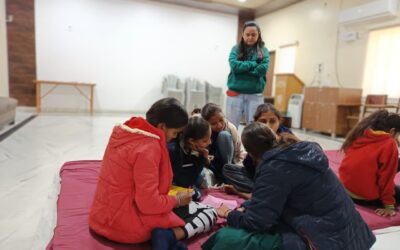“You won’t find a Sal tree growing in a park, for instance, nor will you encounter an avenue of Sal trees. Foresters tell us that Sal trees die of ‘loneliness’ when they are planted singly.”
Pradip Krishen writes about Sal (Shorea robusta) in the preface to “The Hidden Life of Trees” beautifully penned by Peter Wohlleben about how trees interact, bond and feel.
I was reminded of this line, on a cloudy September morning, in Dehradun, Uttarakhand. On my way to visit a temple of Goddess Kali (Daat Kali Mandir), on Sharanpur Road. I noticed that the construction I have been hearing for so long is progressing to materialize. The temple falls along the lines of the 210km Delhi-Dehradun Expressway, particularly in the Greenfield phases of the project.
Delhi Dehradun Expressway
There are four phases to the project:-
- Phase1: Brownfield 32 km [Akshardham, Delhi and Eastern Peripheral Expressway, Baghpat, Uttar Pradesh]
- Phase 2: Brownfield 118km [Baghpat to Saharanpur, Uttar Pradesh]
- Phase 3: Greenfield 40km [Saharanpur, Uttar Pradesh to Ganeshpur, Uttarakhand]
- Phase 4: Greenfield 20km [Ganeshpur, Uttarakhand to Dehradun, Uttarakhand]
The last greenfield stretches are passing through eco-sensitive zone of the Rajaji Tiger Reserve and the Shivalik Elephant Reserve. The project required the state to give up 10 hectares of reserve forest from the eco-sensitive zone of Rajaji. It involved axing down 2500 Sal trees in Uttarakhand, yet again Sal on the retreat for progress. Time and again, in the name of the development of mankind, these majestic benevolent creatures are axed down. Once it is the 19th Century railway ‘sleepers’, then ironically the Wildlife Institute of India and now the 21st Century ‘expressway’.
What Is So Majestic About Sal?
As a child I use to hear the adults say, “Sal sau saal khada, sau saal padaa, sau saal sadaa” (a Sal tree grows for 100 years, stays on the forest floor for 100 years and rots for a 100). This highlights how while living and as well in death the benevolent keeps on giving.
Sal is a Dipterocarp, a significant and ancient family of very gregarious, emergent trees from tropical biomes girdling the globe from the Americas and Africa, all the way across Asian tropical forests. In India, Sal tree has an umbrella-handle-shaped distribution all the way along the base of the Himalayas, curving back from Eastern India, moving to Central India with ending in Chhattisgarh.

A Sal tree never grows alone, it is always a community of young, old, dead and living, supporting each other. Whenever you visit a Sal forest, which you should plan in between March-April that is the best time. You would be greeted by the smell of fresh leaves and glistening sun rays piercing in between the gaps of their majestic canopy. Meanwhile the forest floor covered with shed dry leaves in shades of red, brown and ochre, that would crunch and crackle with each one of your footsteps.
Like The Golden Snitch!

In midst of this rustle and crackle you would find the ‘helicopter’. A brown flower like thing almost similar in appearance to the Golden Snitch. You would have found or rather seen as the forests floor would be covered with them, the Sal seed with its unmistakable wings. Sal seeds are an aerodynamic wonder, with a circular yet conical appearing seed adorning wings to help them ‘fly’. A walk along the forest with dusky pleasant winds blowing over these trees would lead you to witness the seed dispersal. These little seeds are flying in almost circular motion to germinate far way from their parent tree.
Sal follows a social and communal living, young and old all live together. The younger ones though far from their parents would grow near the towering and stout trunks of the older trees. The young ones have smooth barks, with less to no branches. They appear to be conserving all their energy to reach the sun. At the top the older ones have grand green crowns that meets the young ones forming a dense canopy.
The older ones unlike the younger have deep furrow on their stout trunks much like the like wrinkles on an elderly human. Even death does not do them apart, a dead Sal stands proud. It is home for a lot ranging from insects and termites, to Hornbills, Woodpeckers, and Squirrels.
Why Is It So Important?
Sal is a valuable tropical hardwood timber species native to South Asia. The Sal trees cover almost 13.30% of total forest area of India. These forests are source of many ecosystem services, harbour rich biodiversity, provide economic sustenance to resource people deeply linked with culture of tribal and ethnic groups of the region.
The trees are known for its superior quality timber of high structural durability and termite resistance (Satya et al. 2005) The bark releases tannins and gums possessing manufacturing and domestic importance (Kumar and Saikia 2020). Young Sal leaves are used for thatching, plate making and their poles for construction materials. (Chitale et al. 2014). The seed provides for seed oil that has a lot of astringent properties. Even the leaf litter creates for a rich ecosystem inhabiting various reptiles like king cobra, monitor lizard etc. The forests have a good climate change mitigation potential by maintaining positive carbon balance in its ecosystems and greater sink capacity (Raj and Jhariya 2021)
An Object Of Veneration
The Sal tree has served as an object of veneration of many tribes ranging from the Himalayan region of Uttarakhand to the tropical forests of Chhattisgarh. The forests in Uttarakhand are always adorned with a “Van Devi” (Forest Goddess) shrine, where the trees are decorated in red threads and cloth. Meanwhile in the tribes of Chhattisgarh no wedding is complete without the invitation of turmeric and rice sent wrapped in Sal leaves and plates made out of them.
Can we not reverse the damage with afforestation?
Since the British era, one thing foresters learnt was that it is very difficult rather impossible to artificially regenerate Sal. It has been known to be stubborn and only grows on its own volition. The puzzle persists till date. It continues to be restricted to undisturbed remnant patches of old growth trees in its natural biome. It creates kilometers of dense forests yet in all its dominance is generous and provides space for others. Amongst the flying seeds of Sal one can spot fiery red foliage of Kusum and mounds of termites around the older dead stump. It is home for lot of rare, common and endangered species and not to forget the vast mycorrhizal fungi network.
One of the biggest reasons for the poor regeneration is that the seeds start germinating just before they detach from the tree. Thus, in artificial regeneration these seeds would immediately require appropriate moisture, nutrients and fungal associates. Which has been a struggle for the Sal nursery industry, as immediate sowing of seeds with appropriate ectomycorrhizal fungal symbionts has not been successful.
What Are The Measures That One Can Take?
Simply put, we need to take responsibility.
Execution of such large-scale projects should not be green lit on the base of Asia’s longest wildlife corridor rather the least amount of impact on forest. It is crucial policy-decision makers understand that such a charismatic species of trees is deserving of stringent conservation. We need to spread the word, but with hard-hitting facts and figures. We need to acknowledge that Sal is not just a tree but a community that interacts, bonds, love, nurtures not just its own but others as well.





0 Comments